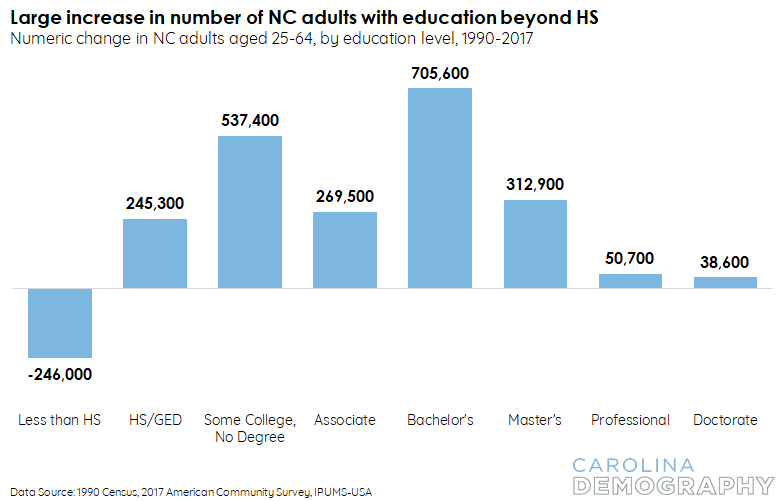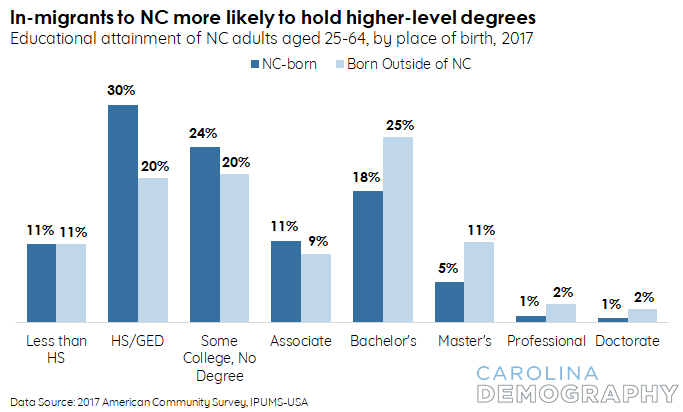In migration plays large role in NC's rising educational attainment
Published March 14, 2019
by Rebecca Tippett, Carolina Demography Center, March 13, 2019.
When we focus on educational attainment, we generally focus on prime working-age adults, defined here as adults between the ages of 25 and 64. There were 5.4 million prime working-age adults in North Carolina in 2017. Of these individuals, 2.3 million or 43.2% held a postsecondary degree:
- 545,000 or 10% had an associate degree
- 2 million or 22% had a bachelor’s degree
- 446,400 or 8% had a master’s degree
- 92,900 or 2% had a professional degree, such as a JD, MBA, or MD
- 64,200 or 1% had a doctoral degree
Among the more than three million North Carolina prime working-age adults without a postsecondary degree, the largest number (1.3 million) had a high school diploma or GED, equivalent to 24% of NC adults aged 25-64. Another 1.2 million reported having some college, no degree, followed by 570,500 with less than a high school diploma, representing 22% and 11% of prime working-age adults, respectively.
How have these populations changed since 1990? The number of adults aged 25-64 living in North Carolina grew by 1.9 million between 1990 and 2017. Over this period, the number of adults without a high school diploma declined by 246,000. This decline reflects generational replacement as, over time, older, less educated workers are replaced by younger workers with higher levels of educational attainment.
At all other levels of attainment, the number of NC workers increased. Compared to 1990, in 2017 there were:
- 705,600 more adults aged 25-64 with a bachelor’s degree, the largest numeric increase of any attainment group.
- 537,400 more adults with some college, no degree. Some of these adults may have nondegree credentials that are not well-captured by the American Community Survey data used here. Many, however, are partway home students who have some college credit (and may have college debt), without a degree or credential to confer workplace benefits.
- 312,900 more adults with a master’s degree.
- 269,500 more adults with an associate degree.
- 245,300 more adults with a high school diploma or equivalent (e.g., GED).
- 50,700 more adults with a professional degree.
- 38,600 more adults with a doctoral degree.
Apart from adults with a high school diploma or less than a high school diploma, all attainment groups grew faster than the overall population growth rate of 56%. The number of associate degree holders increased 98% and the number of postsecondary degree holders at all other levels more than doubled over this period. As a result, the share of North Carolina adults with a postsecondary degree increased 16 percentage points, rising from 27.2% in 1990 to 43.2% in 2017.
Much of the state’s growth between 1990 and 2017 was fueled by net in-migration, and this in-migration also fueled the steady increase in the number of NC adults with a postsecondary degree. Since 1990, the state population of prime working-age adults with a postsecondary degree increased by 1.4 million—974,600 or 70% of these new residents with a postsecondary degree were born outside of North Carolina. In 2017, 36% of NC-born adults aged 25-64 had an associate degree or higher compared to 50% of adults born outside of NC. (Note: sum of proportions in chart differs due to rounding).
North Carolina-born adults and adults born elsewhere were equally likely to report having less than a high school diploma. Compared to individuals born in another state or country, North Carolina-born adults aged 25-64 were more likely to have a high school diploma or equivalent; some college, no degree; or an associate degree. Individuals born in another state or country were more likely than their NC-born peers to hold bachelor’s, master’s, professional, or doctoral degrees.









